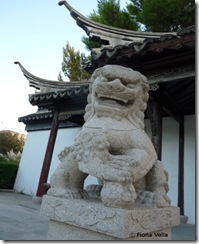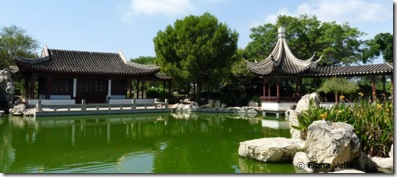-
Visions of China
Travellers and explorers have always fascinated me since I tend to feel enticed by the unknown and the unusual. Their experiences have urged me to make my own discoveries in this overwhelmingly disparate planet that is made up of a multitude of different cultures, beliefs and traditions. Interestingly, such exciting revelations can be just a step away, as my meeting with Gu Hongxing, Director at the China Cultural Centre in Malta, confirmed.
A brief walk along the old Maltese houses in Melita Street, Valletta instilled in me a strong feeling of traditional local culture and architecture. Yet intriguingly, one particular huge door lead to a compellingly contrasting experience: a portal into the alluring world of China. Once inside, my eyes absorbed the distinctive Chinese furnishings that were splendidly chosen to merge elegantly with the Maltese building structure. Likewise, when warmly greeted by Gu Hongxing, I realized that such a refined blending could also definitely take place between the peoples of both countries.
The China Cultural Centre was established in Malta in 2003 with the aim of promoting and enhancing cultural exchange and cooperation between Malta and China. Along the years, it has provided a variety of training courses and organized many cultural activities in order to nourish mutual understanding and friendship among the two countries. In fact by now, a good number of Maltese have become members of this cultural centre and have therefore enjoyed the benefits of cultural exchange activities.
Further knowledge about China is stimulated through the extensive library which boasts a selection of over 11,000 books, newspapers and periodicals, as well as electronic materials in both Chinese and English, most of which are available for circulation. The books generally cover a vast range of subjects such as China’s politics, economy, culture, history, geography, religion, natural environment, and science. Other books relate to masterpieces on Chinese and foreign literature, drama, dance, fine art, photography, films and television. Similarly, the electronic reading materials include editions on China’s economic development, places of interest, folk custom, culture, religion, music pieces of traditional music, films and TV series.
This cultural centre is also equipped with a comfortable classroom, a function room and an exhibition hall which are customarily used by its members. During my visit, the function hall was accomodating 25 Maltese students who were attending to a traditional Chinese painting course. The course which lasted three weeks was delivered by a professional Chinese painter from the Hubei Institute of Fine Arts, Xie Xiaohong.
Traditional Chinese painting is one of the oldest artistic traditions in the world that are still in practice. This art is known to aid to quiet the mind and to expand creative self-expression and discipline. During this course, the participants had the opportunity to learn both the theory and the techniques for painting a variety of subjects as well as different styles of paintings, such as line paintings, meticulous paintings and free-sketch paintings. Copies of antique Chinese paintings were distributed among the participants in order to encourage them to imitate them or to get inspired by them. Eventually, each student had to produce at least three new works of art in order to portray the skills that were learnt.
Gu Hongxing was delighted with the thorough interest that was shown by the numerous attendants. Likewise, painter Xie Xiaohong was impressed by the final outcomes of the students. The participants’ work was finally exhibited in the centre’s exhibition hall so that both the members and the public could appreciate the resulting achievements. The course was only intended to deliver a basic knowledge of traditional Chinese painting. However, all the participants that I talked to, perceived that they had received the value of much more.
Claire told me that the students were provided with all the material required such as ink, colours, brushes and rice paper. Although aware that this was a basic course, she felt that they had actually covered a lot of ground. She explained about line paintings and showed me how in Chinese traditional paintings, differing types of lines are used to represent texture, light and shadow.
Astrid was observing a copy of an ancient Chinese painting which had been done by the method of meticulous painting. Intensely focused on coming out with a creation of her own, she described to me the customary use of black ink in such works, whilst she trasmitted soft studied brush strokes on the opaque rice paper in front of her. Indeed, she acknowledged that this course will surely be a strong inspiration to her future paintings.
Mark, a graphic designer by profession, had decided to attend this course together with his girlfriend Andrea. Usually accustomed to perform his artworks by the use of a computer, Mark was curious to explore the possibilities of a different technique. His artworks, clearly identified by a distinct signature, proved that he had succeeded to master the basic skills that he had been taught. Meanwhile, he explained to me in great detail the significance behind Chinese traditional paintings which tend to depict just one concept whilst leaving a void as a background, unlike Western art. He divulged that this is a painting method which allows each viewer to complete the illustration through one’s imagination. For example, the painting of a smoothly sliding fish may instantly create the illusion of a swimming fish thereby permitting the mind to fill in the rest of the scene. Similarly, a fish in a swerving vertical position may give the impression of it being just caught by some lucky fisherman. Both Mark and Andrea agreed that good comprehension of such a foreign art would not have been possible without the theoretical part of the course, during which the students were introduced to the history and development of such methods.
Tamara and Abigail admitted that they are fascinated with the culture of Asia in general because they consider it highly artistic. In fact, they had already participated in another course related to Chinese paper-cutting. They believed that such courses provided the significant opportunity to familiarize themselves with another culture and also to meet artistic professionals from whom they could obtain new skills.
Each month, members are informed about the regularly new activities that are organized by the China Cultural Centre. Some courses, such as the Chinese language courses, include also a fantastic award for the two most excellent students of every scholastic year – a complimentary Award Tour in China that is organized by the Ministry of Culture of China.
I left the centre with the pleasant feelings of accomplishment and discovery. It was admirable how much the people of China were determined to reach out to the Maltese in order to share and exchange both countries’ different ideas, traditions and cultures. Undoubtedly, as Henry Miller once said “One’s destination is never a place, but a new way of seeing things.”
The China Cultural Centre can be reached at 173 Melita Street,Valletta. Further information may be obtained by calling 21225055 or by email cccmal@culturalink.gov.cn or by accessing the website http://malta.cccweb.org/mt/
Courses at the China Cultural Centre in Malta
Course: Chinese martial arts (popularly known as Kung Fu)
Provided by: Master Dong Fuming, a renowned Wudang Martial Arts teacher from China. This course is ideal for those who wish to develop their knowledge of Chinese martial arts and to experience the basic Kung Fu movements. The course will teach participants how to control their body and mind and to perform a set of Wudang Kuangfu forms.
Venue: Mediterranean Regional Centre for Traditional Chinese Medicine, Kordin, Paola.
Application deadline: 15 October 2012
Course duration: 15 October 2012 till 26 October 2012
Time: 18:00 – 20:00, every Monday to Friday
Tuition fees: €50 for China Cultural Centre members and €60 for non-members for a total of 10 sessions
Course: Chinese language class (4 types of courses available: from beginners to advanced)
Application deadline: 19 October 2012-09-18
Course duration: 30 sessions of each level that will extend from the mid of October this year to the mid of June next year.
Time: Depends on which course chosen.
Tuition fees: The fee per year will be €100, plus €12 for adult and €7 for students as an annual membership subscription.
(This article was published in FIRST magazine (October 2012 issue) with The Malta Independent on Sunday)
Category: Malta Independent on Sunday - First magazine, Torca - Features & Articles | Tags:


